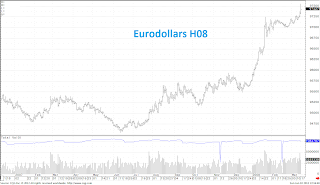I didn't realize it at the time but in retrospect the great grain bull market of early 2008 peaked on the liquidation of the rogue trader at MF Global which stuck the firm with a $141 million dollar loss. The best explanation of the circumstances are in the DOJ press release:
DOJ: MEMPHIS AREA MAN INDICTED FOR CAUSING MF GLOBAL TO LOSE $141 MILLION ON UNAUTHORIZED TRADES OF WHEAT FUTURES CONTRACTS AT CHICAGO BOARD OF TRADE IN 2008
Amazing to think that at the peak of the grain bull he was short 17,181 wheat contracts on that night by the time it was limit up! Click to enlarge all charts.
On a bigger picture time frame to understand the entire grain bull, here is some longer term perspectives,
Above is daily Chicago March wheat.
Above is 30 minute Chicago March wheat top.
Above is daily KC March wheat.
Above is the top in KC March wheat 1 minute chart.
Above is the top in KC March wheat 30 minute chart.
Above is Minneapolis March wheat, really amazing move and I got to hear some legendary stories when I was up there for the floor closing at year end.
Above is the top in Minneapolis March wheat, 1 minute chart.
Above is the top in Minneapolis March wheat, 30 minute chart.













































